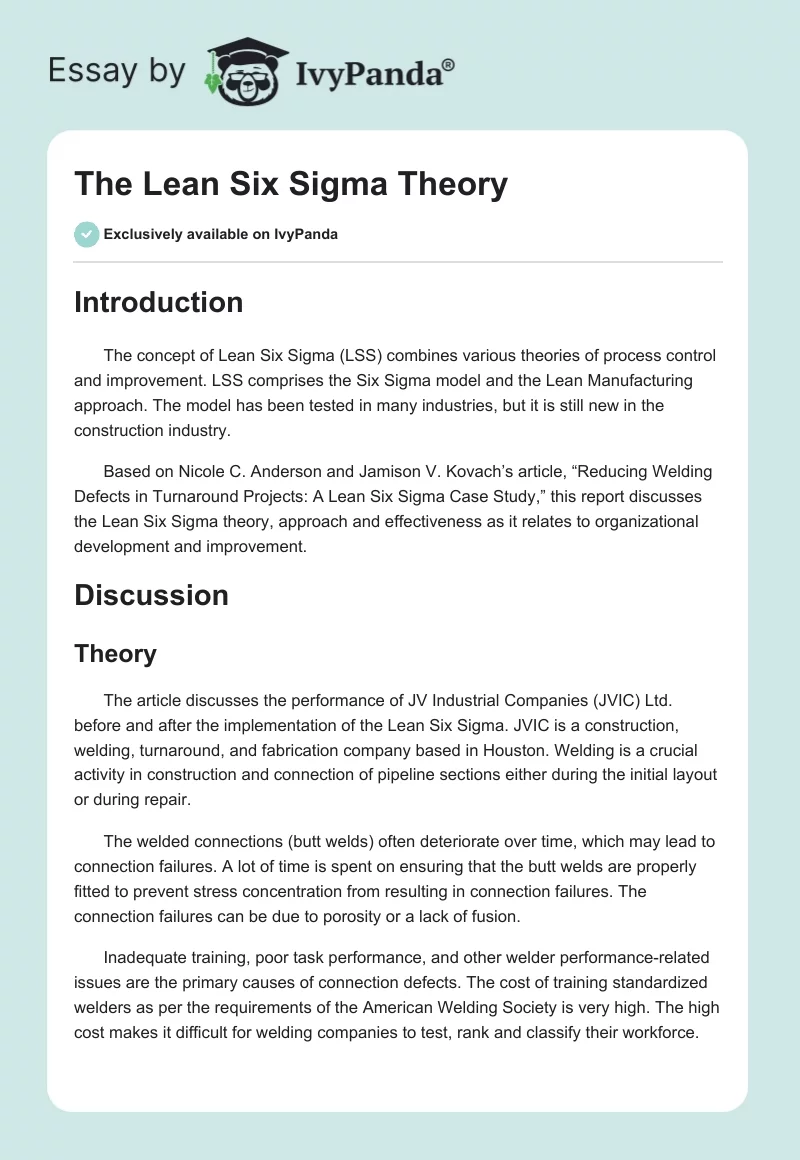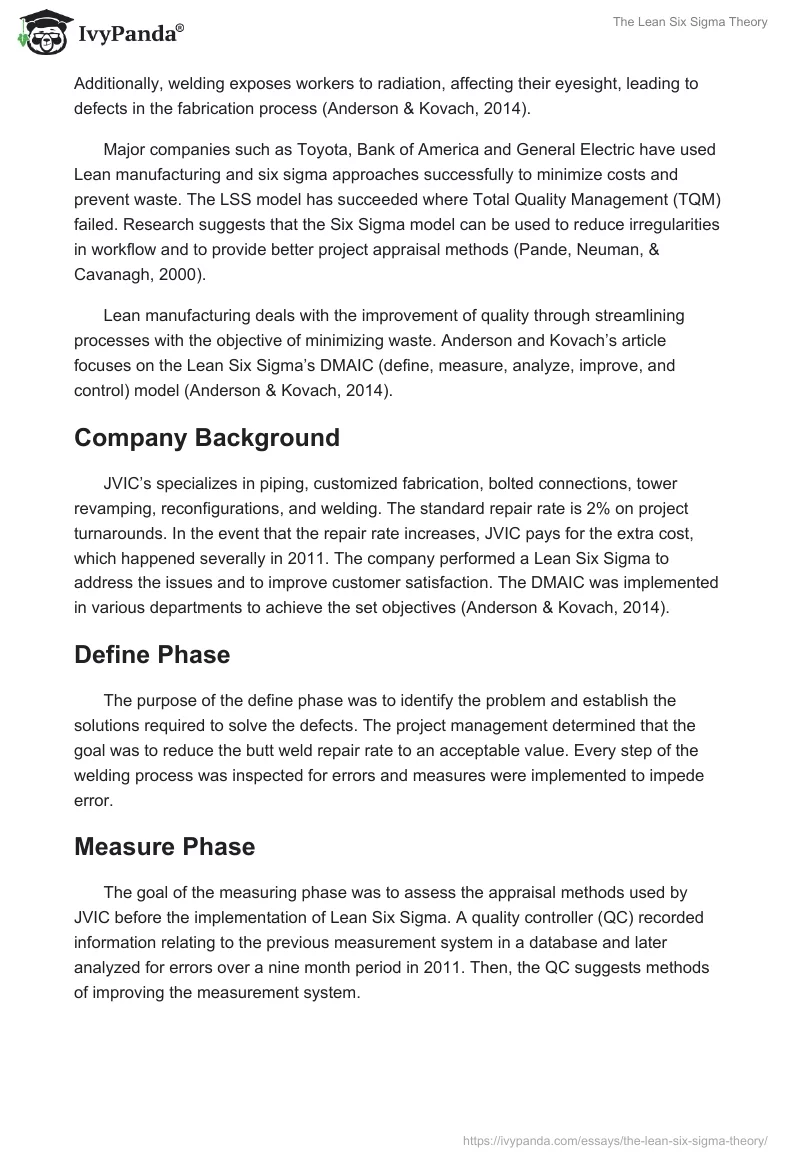Introduction
The concept of Lean Six Sigma (LSS) combines various theories of process control and improvement. LSS comprises the Six Sigma model and the Lean Manufacturing approach. The model has been tested in many industries, but it is still new in the construction industry.
Based on Nicole C. Anderson and Jamison V. Kovach’s article, “Reducing Welding Defects in Turnaround Projects: A Lean Six Sigma Case Study,” this report discusses the Lean Six Sigma theory, approach and effectiveness as it relates to organizational development and improvement.
Discussion
Theory
The article discusses the performance of JV Industrial Companies (JVIC) Ltd. before and after the implementation of the Lean Six Sigma. JVIC is a construction, welding, turnaround, and fabrication company based in Houston. Welding is a crucial activity in construction and connection of pipeline sections either during the initial layout or during repair.
The welded connections (butt welds) often deteriorate over time, which may lead to connection failures. A lot of time is spent on ensuring that the butt welds are properly fitted to prevent stress concentration from resulting in connection failures. The connection failures can be due to porosity or a lack of fusion.
Inadequate training, poor task performance, and other welder performance-related issues are the primary causes of connection defects. The cost of training standardized welders as per the requirements of the American Welding Society is very high. The high cost makes it difficult for welding companies to test, rank and classify their workforce. Additionally, welding exposes workers to radiation, affecting their eyesight, leading to defects in the fabrication process (Anderson & Kovach, 2014).
Major companies such as Toyota, Bank of America and General Electric have used Lean manufacturing and six sigma approaches successfully to minimize costs and prevent waste. The LSS model has succeeded where Total Quality Management (TQM) failed. Research suggests that the Six Sigma model can be used to reduce irregularities in workflow and to provide better project appraisal methods (Pande, Neuman, & Cavanagh, 2000).
Lean manufacturing deals with the improvement of quality through streamlining processes with the objective of minimizing waste. Anderson and Kovach’s article focuses on the Lean Six Sigma’s DMAIC (define, measure, analyze, improve, and control) model (Anderson & Kovach, 2014).
Company Background
JVIC’s specializes in piping, customized fabrication, bolted connections, tower revamping, reconfigurations, and welding. The standard repair rate is 2% on project turnarounds. In the event that the repair rate increases, JVIC pays for the extra cost, which happened severally in 2011. The company performed a Lean Six Sigma to address the issues and to improve customer satisfaction. The DMAIC was implemented in various departments to achieve the set objectives (Anderson & Kovach, 2014).
Define Phase
The purpose of the define phase was to identify the problem and establish the solutions required to solve the defects. The project management determined that the goal was to reduce the butt weld repair rate to an acceptable value. Every step of the welding process was inspected for errors and measures were implemented to impede error.
Measure Phase
The goal of the measuring phase was to assess the appraisal methods used by JVIC before the implementation of Lean Six Sigma. A quality controller (QC) recorded information relating to the previous measurement system in a database and later analyzed for errors over a nine month period in 2011. Then, the QC suggests methods of improving the measurement system.
Analyze Phase
The project team employed a five-why analysis to brainstorm and identify the causes of the increased repair rates. The potential causes of higher repair rates were grouped into materials, environment, measurement, methods, machines, and people.
The failure mode and effects analysis (FMEA) was used to identify potential problems in each step of the welding process. The team allocated a risk priority number (RPN) to various issues based on occurrence, severity, and detection. The researchers identified the problems associated with the highest RPN as the root causes to the defective welds.
Improve Phase
The project team discovered that incorrect windshielding and use of bad welding techniques were the two main root causes of defective butt welds. The improve phase involved further brainstorming with the objective of finding solutions to the problems. Various solutions were proposed for each cause and the best four rated solutions approved by JVIC management. Several months down the line, improvement checks showed that JVIC had saved $90,000 in labor costs.
Control Phase
In this phase, the objective is to sustain the improvements and gains made upon implementation of Lean Six Sigma. The control plan involved training employees to maintain standards, recording improvements over time, and a performance appraisal.
Conclusion
Comparing the Six Sigma quality management approach learned in class and the model proposed by Anderson and Kovach, it is evident that the concepts of DMAIC are constant. However, the article focuses primarily on waste reduction and cost control rather than Total Quality Management (TQM).
In contrast, the article adds the concept of lean management to the Six Sigma model, making it more advanced compared to the Six Sigma Way. The article’s focus on Lean Six Sigma proves that TQM has become obsolete in the field of contemporary quality management approaches.
Reference List
Anderson, N., & Kovach, J. (2014). Reducing Welding Defects in Turnaround Projects: A Lean Six Sigma Case Study. Quality Engineering, 26(2), 168-181, DOI: 10.1080/08982112.2013.801492
Pande, P., Neuman, R., & Cavanagh, R. (2000). The Six Sigma Way: how GE, Motorola, and other top companies are honing their performance. New York: McGraw-Hill.


